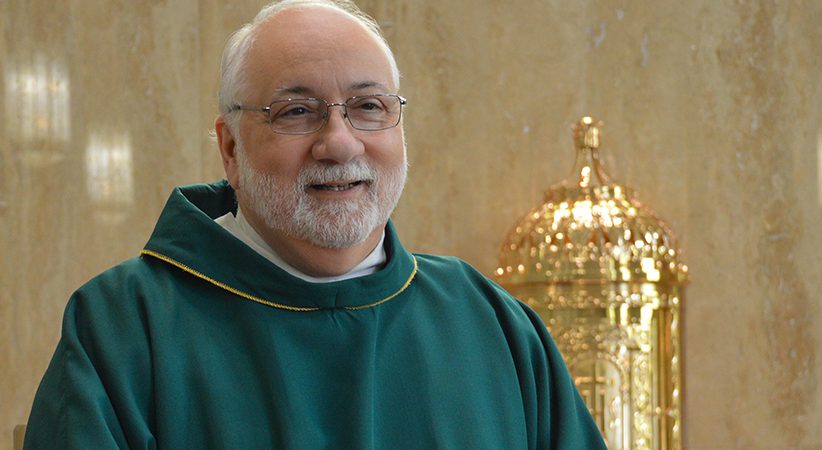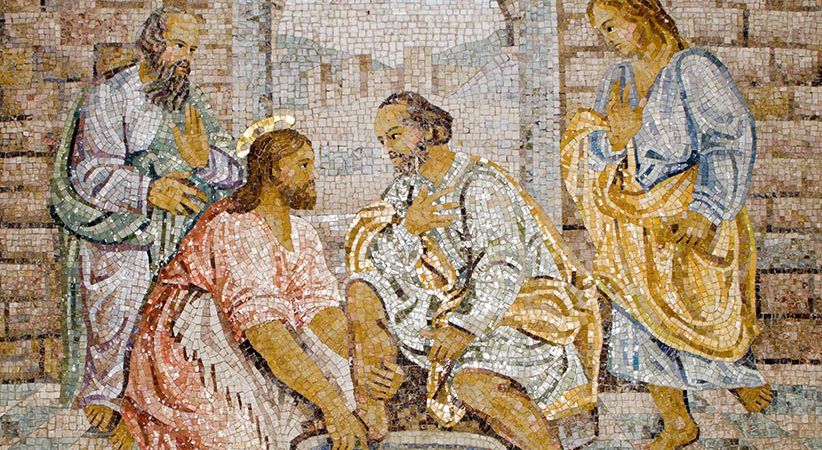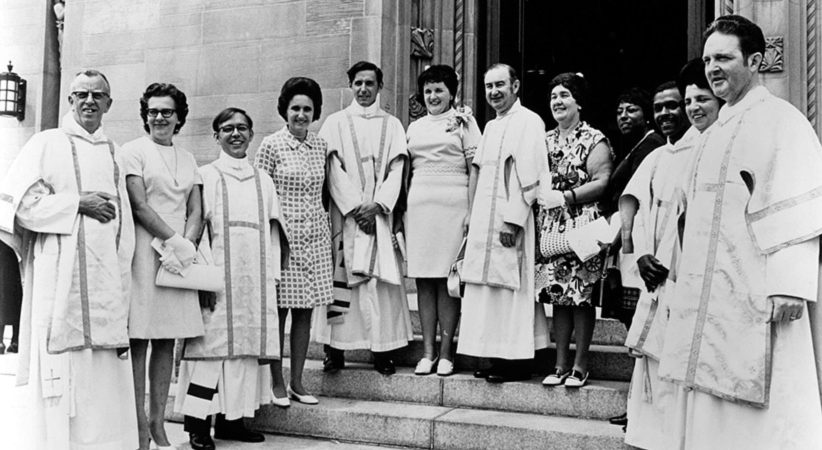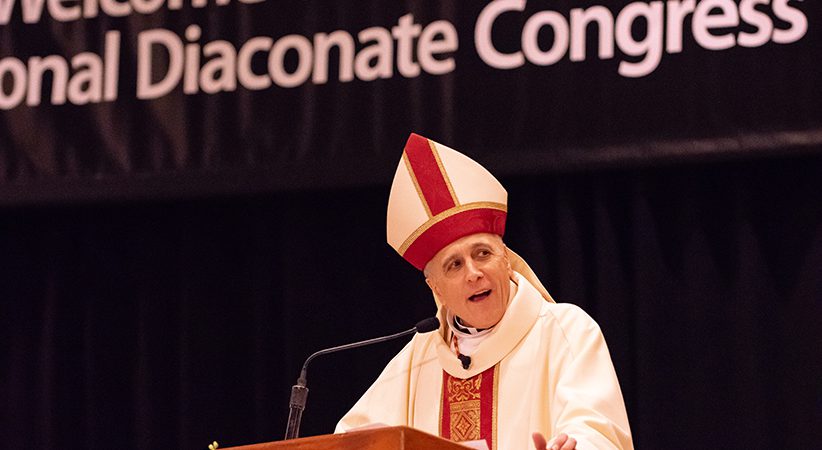A Look at ‘Interior Castle’ by St. Teresa of Ávila
Invitation to read: A delicious warning
Deacon Anthony Clishem Comments Off on A Look at ‘Interior Castle’ by St. Teresa of Ávila
Had Teresa of Ávila written “Interior Castle” (Noll Library, OSV, $29.95) for men called to the permanent diaconate, she might have introduced them to the book’s contents with a “delicious” warning — the word “delicious” being one she would also pair with such words as “wound,” “suffering,” “torture” (p. 118) and “death” (p. 77). She could supply the words for such a warning by lifting them from the end of her book and reinserting the text, prologuelike, at the beginning: “Do you know what it is to be truly spiritual? It is for men to make themselves slaves of God — branded with His mark, which is the Cross. Since they have given Him their freedom, He can sell them as slaves to the whole world, as He was, which would be doing them no wrong but the greatest favor. Unless you make up your minds to this, never expect to make much progress” (p. 225).
Knowing this, the deacon might pause to ask, “Do I need to read this book?” If yes, then perhaps it would be for no better reason than to expand the capacity of his heart to serve. “Interior Castle” provides the secrets by which such an expansion is understood and becomes possible.

Treatise on Prayer
At first, the task before Teresa seems daunting, and she begs the Lord to speak on her behalf. To write well about prayer would give shape and form to the seemingly indescribable. If there were a conceit by which that could be done, what would it be? Pondering this, she shifts her focus from the act of praying to the locus where prayer occurs — the soul — and wonders how one might describe that “place” within the human person.
She writes, “An idea occurred to me which I will explain, and which will serve as a foundation [for this treatise]. I thought of the soul as resembling a castle” (p. 5).
The castle as a metaphor provides a literary device with enough elaborative power to take her to (most of) the places she would like to go. In part, the purpose of the book will be to describe this castle, but more so will it be to recount the journey one takes within its imagined walls. At times, making one’s way through it will seem utterly impossible. Notwithstanding, the ultimate aim will be to gain entry into the castle’s innermost “keep” (p. 14) where only “His Majesty” (p. 29) resides. He reserves it for himself in the very center of the soul.
That God prepares such a room for himself in the interior castle says something remarkable about the human soul despite the state into which it has fallen. Its dignity and beauty are as unfathomable as God himself. He has “formed” this castle “of a single diamond or a very transparent crystal, and containing many rooms, just as in heaven there are many mansions” (pp. 5-6). Moreover, “the Sun within the palace enlightens every part” (p. 15), though, as Teresa points out, “the sun in the center of the soul, which gave it such splendor and beauty, is totally eclipsed” (p. 12). Noting the darkness, she laments: “O Jesus! how sad a sight must be a soul deprived of light! What a terrible state the chambers of this castle are in!” (p. 13).
First Three Mansions
Teresa describes the starting point — or first mansion — in imagery both stark and disturbing, for the devil has staked his own claims on the soul. One enters by way of the basement accompanied by reptiles and other worldly creatures. These are the sinful habits and temptations that obscure one’s sight, preventing one from “seeing the beauty of the building,” and so, Teresa adds, “[it] is great gain that these persons should have found their way in at all” (p. 9).
Yet, one does not begin the journey without hope. Teresa adds that this mansion contains “such treasures that if the soul only manages to elude the reptiles dwelling here, it cannot fail to advance farther” (p. 17). Yet, the devil, in his anger, does not easily give up, keeping “legions of evil spirits hidden in each room to stop the progress of Christians, whom, being ignorant of this, he entraps in a thousand ways” (p. 17). It is “because we creatures possess little strength for self-defense,” and because “in every state of life all our help must come from God” (p. 17), that Teresa invokes her greatest admonition: to seek humility. In the spiritual life, it is, “of first importance” (p. 17).
The journey has only just begun. To advance from the first mansion and enter the second one must be willing to withdraw further away from worldly preoccupations, which distract the soul from responding to the various ways God is calling. The devil redoubles his efforts as the resistance one feels to spiritual progress intensifies. The soul suffers more than before because now it is more keenly aware of its sins and need for forgiveness. To avoid discouragement and aided by grace, the soul must seek perseverance, what Teresa calls, “the first essential” (p. 25).
Those who enter the third mansion have gained many graces and survived many trials. In this mansion, one finds the rooms of the rich young man (cf. Mt 19:16-22). Like him, those who have progressed to this level enjoy the fruit of their labor. They avoid venial sins and embrace repentance. They have learned the practice of meditation. They govern themselves and their affairs well and engage in works of charity (cf. p. 36). By their work and sacrifice, they have attained much and received many graces but lack one thing: a readiness to “detach” from all they have, to become poor (p. 42). In his prayer, he seeks only consolations while rejecting the dryness necessary for the soul to advance (p. 36). Returning to the need for humility, Teresa does not soften her message lest one think it possible to have it any other way: “The object of our life must be to do what He requires of us: let us not ask that our will be done, but His. If we have not yet attained to this, let us be humble. … Humility is the ointment for our wounds” (p. 42).
Once healed of its attachments, the soul will benefit from a greater desire to serve God. Teresa’s words cut to the heart: “How little is all we can do for such a generous God. … for He did nothing else during the whole time He lived in this world but serve us” (p. 38).
Fourth and Fifth Mansions
As one progresses in the spiritual life, Teresa notes that many years may pass before one attains to the next mansions. She identifies a marked difference in the castle as one leaves the preceding mansions to enter the fourth. Here the mansions present their “supernatural” (p. 49) nature, more difficult to explain than the previous ones. Progress in prayer will no longer depend on human effort but all the more so on how the soul disposes itself to God’s grace.
In the fourth mansion, the soul experiences “divine consolations” (p. 58). Unlike the “sweetness in prayer” (p. 50) one has previously experienced (resulting from one’s own efforts), it is God who initiates this new experience of prayer. To explain the difference, Teresa finds a helpful metaphor in water. Whereas a man might supply from a distance his need for water by means of an aqueduct he builds to fill his basin, it is now God himself who fills it as from an eternal spring (cf. p. 58). These new consolations in prayer, writes Teresa, “[produce] the greatest peace … in the inmost depths of our being” (p. 59) about which she admits, “I know neither where nor how” (p. 59).
Teresa also admits her dumbfoundedness in speaking of the many rooms in the fifth mansion, “Would it not be better,” she wonders, “to say nothing about them” (p. 75)? Here the soul experiences what she calls, “the prayer of union” (p. 77). The soul best disposed to receive this favor emulates the merchant who sold all to purchase the pearl of great price (cf. Mt 13:46). By this sign, Teresa writes, “[The soul] has died entirely to this world, to live more truly than ever in God” (p. 77). In the prayer of union, one enters a state of contemplative prayer wherein the “soul is asleep, fast asleep, as regards the world and itself” (p. 77). It is that “delicious death” by which one “seems to have left its mortal covering to abide more entirely in God” (p. 77).
The Final Mansions
Teresa has devoted less than half her treatise to the first five mansions. She will dedicate more than half to the final two. As the soul gains entry into the sixth mansion, Teresa warns, it must not confuse the favors it has already received with those it will still require to attain the final goal. The journey is not over. As the soul prepares to receive new graces from God, something more will be required of it: a willingness to suffer for Christ. Teresa writes, “Do not imagine it will cost you nothing and that you will find it all done for you: think what the love He bore for us cost our Spouse, who to free us from death himself suffered the most painful death of all — the death of the cross” (p. 97).
The trials one faces in the sixth mansion are of such a number and nature that Teresa adds, “Were they known beforehand … [one would not] resolve to encounter them” (p. 108). These include psychological suffering, such as what results from gossip, lies and abandonment by friends, as well as painful bodily infirmities that affect both body and soul. Perhaps the most difficult kind, she notes, are the spiritual, which include such trials as scruples, questioning one’s love for God, and the confusion that can be wrought by a poor confessor. With these can also come the trials caused by demons.
…………………………………………………………………………………………………………………………………………………..
‘Interior Castle’ and the Noll Library
Teresa of Ávila’s “Interior Castle” (Noll Library, OSV, $29.95) guides the spiritual seeker through each stage of development until the soul’s final union with the divine. The book is part of the Noll Library package, a contemporary selection of Catholic classics, curated for the modern reader by Our Sunday Visitor in the spirit of OSV’s founder, Archbishop John Francis Noll.
(Noll Library, OSV, $29.95) guides the spiritual seeker through each stage of development until the soul’s final union with the divine. The book is part of the Noll Library package, a contemporary selection of Catholic classics, curated for the modern reader by Our Sunday Visitor in the spirit of OSV’s founder, Archbishop John Francis Noll.
……………………………………………………………………………………………………………………………………………………
Yet God does not abandon the soul to battle these trials alone. In the rooms of this mansion, he provides the soul with many signal graces. Some come into the soul with desires so “delicate and subtle” that “the soul itself cannot discern them” (p. 118) though they can be known by their effects, such as greater “conviction, peace, [or] interior joy” (p. 128). Other favors come as “raptures’’ (p. 134) by which God imprints divine mysteries upon the soul. Still others present visions both intellectual and imaginary such that the soul “for some time afterward possesses such certainty that this grace comes from God that whatever people may say to the contrary it cannot fear delusion” (p. 179).
After a lengthy betrothal (cf. p. 100), the soul at last arrives at the door of the seventh mansion. Having found no better comparison than to the Sacrament of Matrimony to describe the journey’s end, Teresa writes: “Before consummating the celestial marriage, [he] brings [the soul] into His mansion or presence chamber … for as He has a dwelling place in heaven, so has He in the soul, where none but He may abide and which may be termed a second heaven” (p. 201).
Here the king removes the “scales” from the eyes of the soul (p. 202) and reveals the Three Persons of the Trinity. The soul senses it will never depart from their presence and desires more than ever to serve God. All the virtues of the soul expand, and all fear takes flight. In this spiritual “wedlock,” the soul knows it will always remain at its center with God (p. 207).
End and Aim of Prayer
Teresa of Ávila’s “Interior Castle” is an exemplar of service to the Word. Echoing the need for such a catechesis on prayer, she writes, “Each of us possesses a soul, but we do not realize its value as made in the image of God, [and so] therefore we fail to understand the important secrets it contains” (p. 200).
The deacon who commits to learning these secrets will also discover more fully his vocation as a servant of charity: “This is the end and aim of prayer … the reason of the spiritual marriage whose children are always good works. Works [of charity] are the unmistakable sign which shows these favors come from God. … Remember, this is of far more importance than I know how to express. Fix your eyes on the Crucified One, and all will seem easy” (pp. 224-225).
Teresa began her manuscript on June 2, Trinity Sunday, 1577. Despite the effects of age and ill health, she completed it six months later on Nov. 22 (the Vigil of St. Andrew). The earliest published edition appeared in 1588, six years after her death. In contrast to her modest expectations, the book would enjoy worldwide and, to the present day, continuous publication, providing evidence enough that her “Majesty” had far more “delicious” plans for the book than even its author could have imagined.
DEACON ANTHONY J. CLISHEM, Ed.D., serves as the Office of Catechetical Formation leader for the Diocese of Joliet, in Illinois.
……………………………………………………………………………………………………………………………………………………
Pope Praises Spiritual Value of Literature and Poetry
By Catholic News Service
VATICAN CITY (CNS) — Every Christian, but especially seminarians, should set aside their screens regularly and spend time with a book of literature or poetry, Pope Francis said. In a world that so often prizes efficiency and accomplishment, “we desperately need to counterbalance this inevitable temptation to a frenetic and uncritical lifestyle by stepping back, slowing down, taking time to look and listen,” the pope wrote. “This can happen when a person simply stops to read a book.”
In a letter, “On the Role of Literature in Formation,” published by the Vatican Aug. 4, Pope Francis said he initially intended to write a letter on how important it is for seminarians to devote time to reading novels and poetry but decided to expand it, because reading is important for “the formation of all those engaged in pastoral work, indeed of all Christians.”
The pope’s letter cited his own experience as a high school literature teacher in 1964-65 as well as essays by the writers C.S. Lewis, Marcel Proust and Jorge Luis Borges, [as well as] texts by Jesuit Father Karl Rahner, St. Paul VI, St. John Paul II and the Second Vatican Council. He also referred to evidence in the Acts of the Apostles that St. Paul knew the work of the poet Epimenides, who wrote in the sixth century [B.C.], and the poet Aratus of Soli from the third century [B.C.].
………………………………………………………………………………………………………………………………………………..





